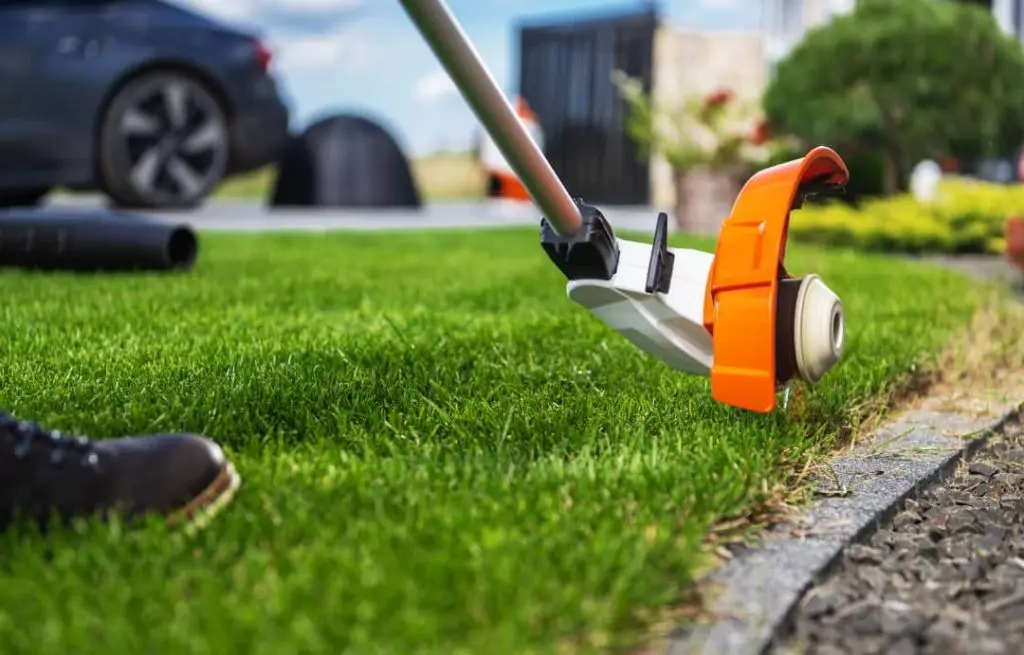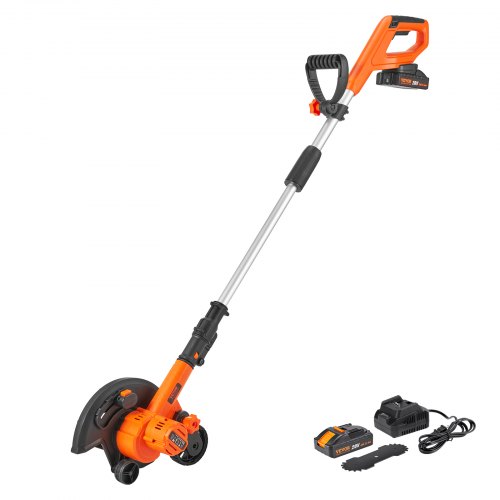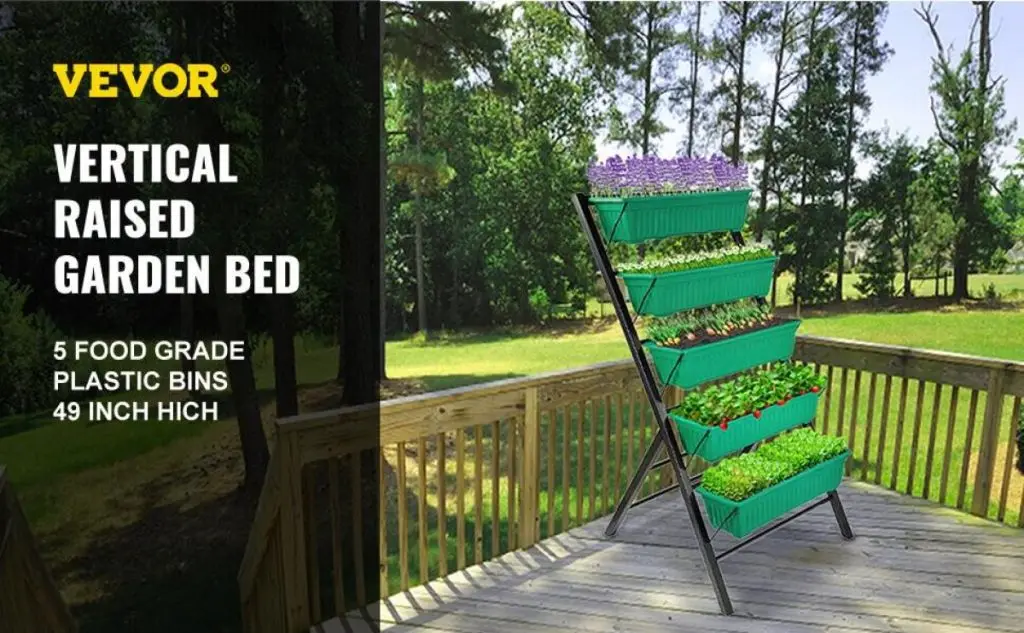A well-edged lawn can make a huge difference to your garden, giving it that clean, polished look that takes your curb appeal to the next level.
Edging creates defined lines between your grass and flower beds, paths, or driveways, adding a professional touch to your outdoor space.
In this guide, we’ll walk you through how to edge a lawn in just five simple steps. You’ll learn the basics, from prepping your lawn to achieving those crisp edges. And with the VEVOR Edge Trimmer, you’ll have the perfect tool to make the process quick and easy.
Just keep reading to learn how to make your lawn stand out!
Table of contents
Why Edge a Lawn?
Edging a lawn isn’t just about neat lines; it’s a simple way to elevate the look and feel of your entire garden. So, knowing how to edge a lawn properly brings both visual appeal and practical benefits.
The Benefits of Knowing How to Edge Properly
Edging improves the overall aesthetics of your property by creating clean, defined lines that separate your grass from flower beds, walkways, and driveways.
This neat border also prevents grass from encroaching into areas where it shouldn’t be; hence reducing the time you spend on maintenance.
Beyond curb appeal, a well-edged lawn can even increase the value of your property, as it signals to potential buyers that the space is well cared for and thoughtfully designed.
Common Mistakes When Edging and How to Avoid Them
Edging a lawn might seem straightforward, but a few common mistakes can lead to uneven lines and accidental damage. If you are thinking of learning how to edge a lawn perfectly, then you should also be aware of these pitfalls and how to avoid them.
One of the biggest mistakes is creating uneven lines. When edging, it’s easy to get carried away, but rushing can lead to wavy, inconsistent edges that ruin the clean look you’re aiming for.
So, how do you edge while avoiding this? Just take it slow, and if possible, mark out a guideline beforehand to keep everything neat.
Another common error is damaging the lawn or surrounding plants. Aggressive edging or using the wrong tool can tear up grassroots or nick nearby plants.
To avoid this, keep a steady hand and use a quality tool, like the VEVOR Edge Trimmer, which is designed to give you control and precision while keeping your garden safe.
We will talk more about this tool in the latter section of this post. Just keep reading!
Essential Tools: How Do You Edge Like a Pro?
To edge like a top professional, you will need some important tools.
Manual Edgers vs. Powered Edgers
When it comes to edging a lawn, you can choose between manual and powered edgers. Each has its pros and cons, so the best option depends on your needs.
Manual edgers, like half-moon spades or rotary edgers, are affordable and give you precise control. They’re perfect for smaller yards and edging around tight corners. However, manual edgers require more physical effort and can be time-consuming for large areas.
Powered edgers, on the other hand, make quick work of large lawns and deliver clean, consistent lines with minimal effort. They’re ideal for bigger spaces or anyone looking to save time. However, powered options may cost more upfront and require a power source or batteries.
For the perfect blend of efficiency and ease, a powered edger is the way to go.
Introducing the VEVOR Edge Trimmer

The VEVOR Edge Trimmer is a powerful, battery-powered edger designed to give you professional-level precision with ease.
It features a 9-inch blade with three adjustable depth settings, making it ideal for lawns, driveways, borders, and sidewalks. The cordless design, powered by a 20V battery, ensures you have the flexibility to move freely without worrying about cords or gas.
With this tool, you can achieve neat, even edges effortlessly, making it a fantastic addition to any lawn care routine.
Recommended For Your Project
Safety Gear and Preparations
Before you start edging, it’s essential to put on the right safety gear and make a few quick preparations.
Gloves protect your hands from blisters and give you a firm grip on the tool. Goggles safeguard your eyes from flying debris, while closed-toe footwear protects your feet from accidental nicks.
It’s also a good idea to wear long sleeves and pants to shield your skin, and to check the area for hidden obstacles, like stones or branches, to prevent unexpected mishaps.
How to Edge a Lawn: Step-by-Step Guide
Follow these simple steps to edge a lawn effectively.
Step 1 – Preparing Your Lawn for Edging
Before you start edging, a little preparation goes a long way toward achieving clean, precise lines.
Begin by mowing your lawn. This helps you see the edges clearly and ensures that your grass is evenly trimmed, giving you a better idea of where you need to edge. Mowing also removes excess grass that could get in the way and keeps the lawn looking neat overall.
Next, mark the edging line. This is essential for creating a straight, professional-looking edge. You can use garden spray paint, string, or even a garden hose to outline the path you’ll follow. This way, you will have a clear guide, reducing the chance of uneven or wavy edges.
Step 2 – Positioning the VEVOR Edge Trimmer Correctly
To achieve the best results here, positioning your trimmer is key to learning how to edge properly.
First, adjust the handle and blade depth on the VEVOR Edge Trimmer. Set the handle to a comfortable height so you can maneuver the tool easily, and choose the appropriate depth setting for your lawn.
The VEVOR Edge Trimmer offers three adjustable depths, allowing you to select a depth that best suits your lawn’s needs and desired edge look.
Next, focus on your standing position and grip. Stand upright with a steady stance, keeping one hand firmly on the handle while guiding the tool with the other. This gives you better control and stability, allowing for smooth, even lines.
Hold the trimmer close to the marked line, with the blade just skimming the grass edge, to keep everything aligned as you move forward.
Step 3 – How to Edge Properly Along Walkways and Driveways
Edging along walkways and driveways requires a steady hand and attention to detail to keep lines clean and professional.
To maintain a straight line, follow your pre-marked edge closely, keeping the trimmer blade just along the border of the grass. Move slowly and keep a steady pace, using your marked line as a guide to ensure evenness.
For the best results, avoid rushing; consistent movement helps create a smooth, crisp edge that enhances the look of your lawn.
For edging curves, take extra care to avoid jagged or uneven cuts. Gently guide the trimmer along the curve, adjusting your pace and direction to match the natural bend. A slight pause with each adjustment can help you follow the curve accurately without disrupting the line.
Step 4 – Edging Around Flower Beds and Trees
When edging around flower beds and trees, start by protecting plants near the edge. Be mindful of the trimmer blade’s distance from delicate flowers, shrubs, or tree roots to prevent accidental damage.
A slower, controlled approach gives you more control and minimizes the risk of harming nearby plants.
Next, focus on creating clean borders. Carefully guide the trimmer to define the boundary around each flower bed or tree, keeping the line distinct and uniform. This clear separation not only enhances the look of your garden beds but also prevents grass from encroaching into these areas.
Step 5 – Finishing Touches and Clean-Up
After you’ve completed the edging, it’s time for a quick clean-up. Remove any debris left behind, including grass clippings and soil, to leave your lawn looking neat and polished. You can use a broom or leaf blower to clear the area efficiently.
Finally, inspect the edges to ensure they’re even and smooth. Make any small adjustments if needed, then step back and admire your work.
These finishing touches make a big difference in giving your lawn a professional, well-maintained look.
Pro Tips for Using the VEVOR Edge Trimmer Effectively
To get the most out of your VEVOR Edge Trimmer, here are a few key tips for how to edge with a weed trimmer like a pro.
#1: Adjusting Settings for Optimal Performance
For the best results, adjust the blade depth and speed settings according to the thickness of your grass and soil type.
A deeper blade setting works well for thicker grass, while a shallower depth is ideal for delicate areas. Adjusting the speed also gives you more control; a slower speed is helpful for precise edges, while a higher speed can handle tougher patches quickly.
#2: Safety Precautions While Edging
Safety should always come first. Avoid obstacles like rocks, roots, or metal that could damage the trimmer or create hazards.
Hold the trimmer with a steady grip and keep it at a safe distance from your body. Taking these precautions helps prevent injuries and keeps you in control.
#3: Troubleshooting Common Issues
If you encounter tough spots, take your time and work slowly to let the blade do the job without forcing it.
For consistent performance, maintain the blade sharpness by cleaning it after each use and checking it regularly for wear. These small maintenance steps will keep your VEVOR Edge Trimmer performing at its best.

Maintenance Tips After Edging
Taking care of your lawn doesn’t end once the edging is complete. Good maintenance practices will help keep your lawn looking sharp and extend the life of your tools.
So, before we round up this guide on how to edge, let’s quickly talk about some important things you need to do after edging.
Cleaning Up After Edging
Once you’re done, clear away any clippings and debris to give your lawn a polished finish.
Properly dispose of grass clippings in compost or yard waste bins, and take a moment to wash down hard surfaces like walkways or driveways to remove any dirt or grass left behind.
This final touch adds to the professional look and keeps your garden area neat.
Maintaining the VEVOR Edge Trimmer
To keep your VEVOR Edge Trimmer in top condition, clean it after each use. Gently wipe down the blade to remove any buildup and store it in a dry, safe place to prevent rust.
Regularly inspect the trimmer for any signs of wear or loose parts, and consider occasional servicing to keep it functioning smoothly.
These maintenance steps will make sure your trimmer is ready for the next time you’re asking yourself, “How do I edge my lawn?”
FAQs About How to Edge a Lawn
How Do You Edge a Lawn Without Damaging It?
To edge your lawn without damage, use a steady, controlled approach and keep the trimmer blade at a safe depth to avoid cutting too deeply into the soil. Always edge slowly around plants and obstacles to prevent accidental nicks.
Can I Edge My Lawn Without a Trimmer?
Yes, you can. You can use tools like a half-moon edger, spade, or even a sharp garden knife. However, while these tools can give decent results, they often require more effort and may not provide the same precision and smooth finish as a powered trimmer.
How Often Should I Edge My Lawn?
Edging frequency depends on factors like grass growth rate, lawn size, and personal preference. Generally, edging every 1-2 weeks in the growing season is ideal, though you may edge less often in cooler months when growth slows down.
Conclusion
Mastering how to edge grass brings both aesthetic and practical benefits to your lawn, giving it a polished, professional look and preventing grass from encroaching on walkways or flower beds.
Knowing how to edge lawns with edger tools, especially with the right techniques, can make a world of difference in keeping your garden neat and well-defined.
For those looking to make the job easier and achieve the best results, investing in the VEVOR Edge Trimmer is a game-changer. This reliable, easy-to-use tool will help you learn how to edge with a trimmer precisely and efficiently, saving you time and effort with each use. We’d love to hear about your edging experiences! Feel free to share your tips, ask questions, or tell us how the VEVOR Edge Trimmer has worked for you.







 Arabic
Arabic Danish
Danish Dutch
Dutch English
English Finnish
Finnish French
French German
German Hungarian
Hungarian Italian
Italian Norwegian
Norwegian Portuguese
Portuguese Romanian
Romanian Russian
Russian Slovak
Slovak Spanish
Spanish Swedish
Swedish